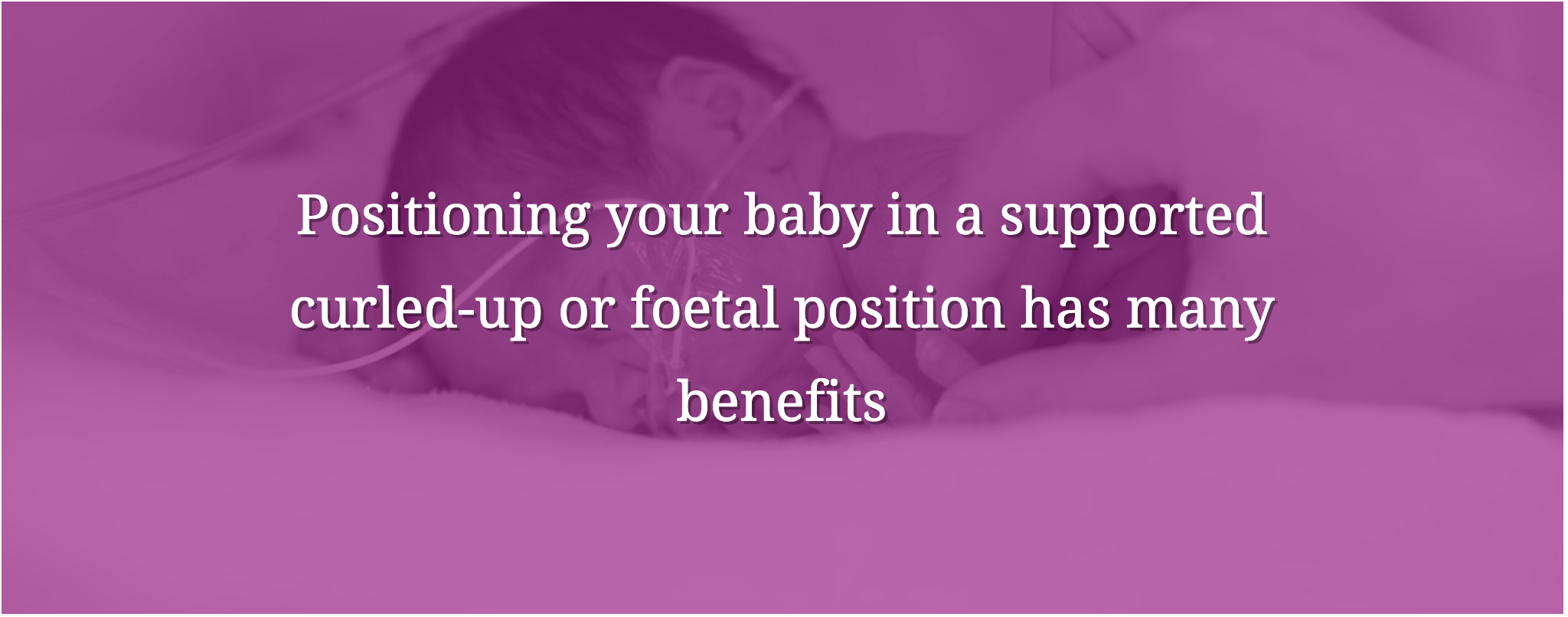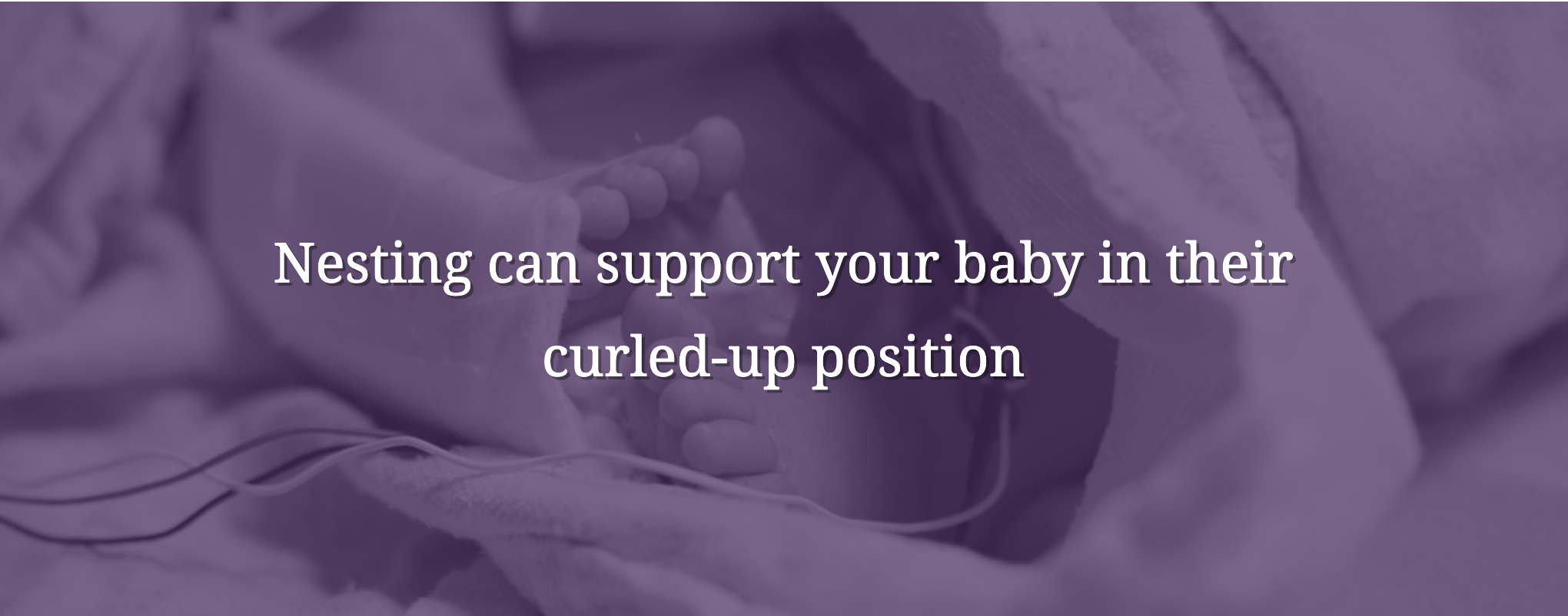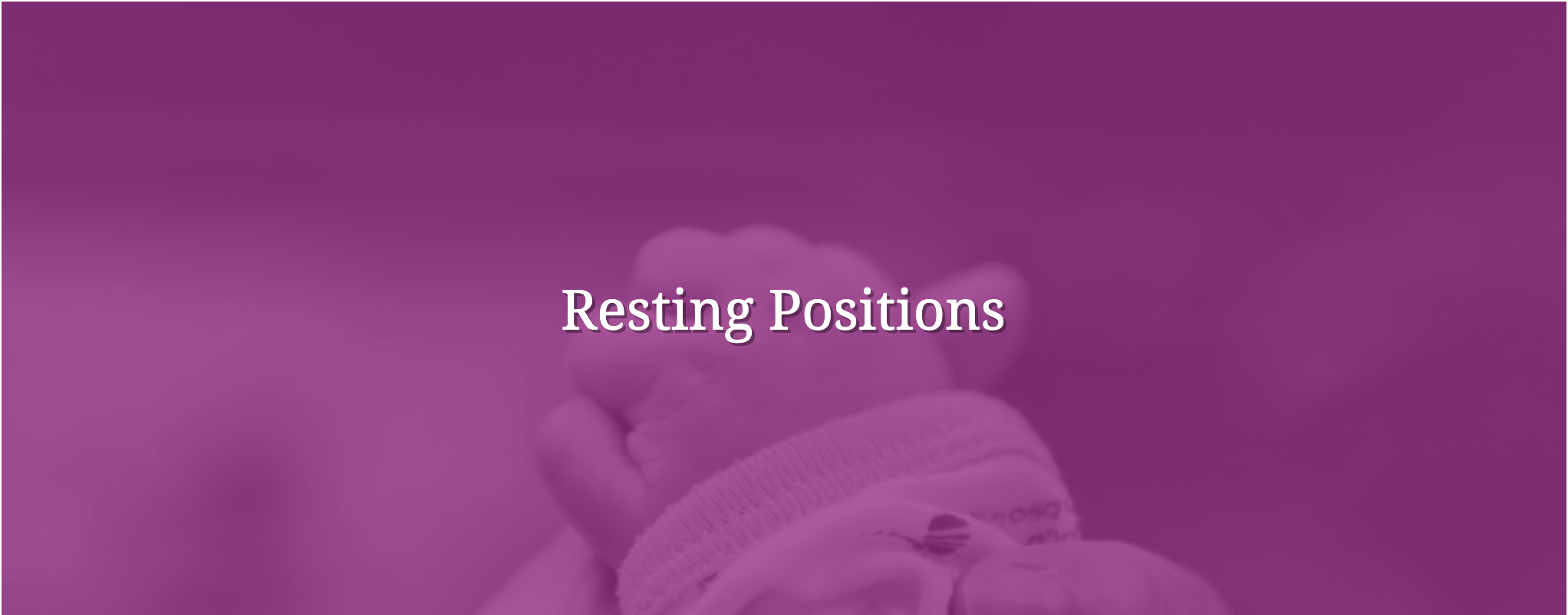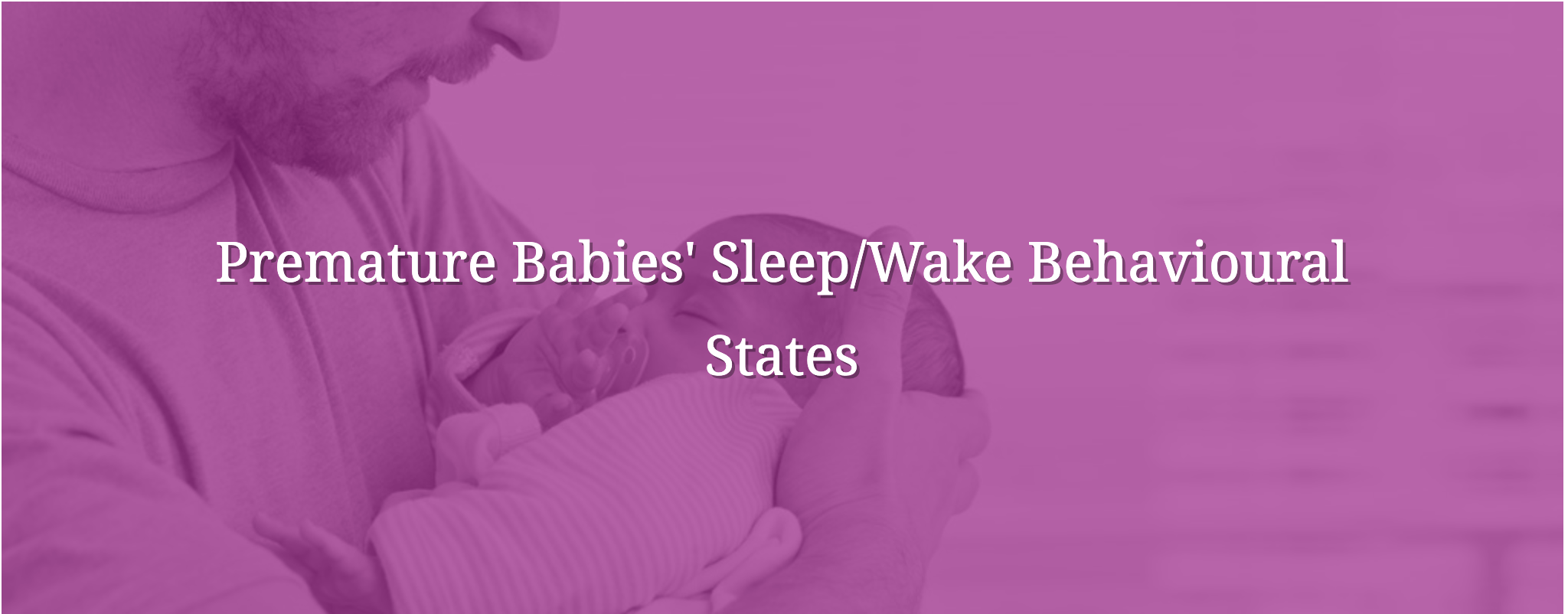Positioning Your Baby
Positioning and handling your baby are important for the development of movement and to help your baby feel secure. Very small babies are most comfortable when they are curled up on their side, with limbs tucked in towards their middle, and are supported in this position. In the NNU, your baby may be placed on their tummy to better settle them. Positioning you baby on their tummy is only appropriate when your baby is being cared for in the incubator.
Preterm babies have less muscle tone and appear more floppy (hypotonic) than full-term babies. Full-term babies often adopt a curled-up or “flexed” position while preterm babies are not as strong and have a less flexed position. Preterm babies tend to let their arms and legs fall out (‘frog-like’) and their head to roll to one side. They can find it difficult to move their limbs because they are no longer supported by fluid in the womb and must learn to move against gravity. They also find it difficult to hold their positions, and their movements may appear jerky. Your preterm baby will not automatically adopt a curled-up position and have to be shown in time by you or their nurse.

Positioning your baby achieves the following benefits:
- It promotes normal muscle development and movement patterns.
- It promotes balanced muscle development; prevents muscle weakness in some areas and muscle tightness in other areas.
- It promotes feelings of security and calm.
- It reduces your baby’s stress and energy expenditure. It preserves energy levels as your baby is more comfortable, sleeps and feeds better, and doesn’t use vital energy to calm and settle.
- It promotes stable and easier breathing and blood circulation.
- Your baby’s positioning should be changed regularly, i.e. regularly alternate the side that your baby is lying on to prevent head flattening known as ‘plagiocephaly’.
- It promotes awareness of their hands. This is important in the development of fine motor skills (the precise use of hands and fingers) and will lead to improved feeding skills later on.
- It encourages your baby to bring their hands to their midline and in front of their body. This is an important early development stage: being a precursor to gross motor skills (use of large muscles in the body) and fine motor skill development.
- It promotes the development of crawling, standing and walking later on.
Your baby’s nurse and/or physiotherapist will show you how to best provide positioning support to your baby.

A nest gives your baby boundaries to push against which will remind them of the boundaries they had when in the womb. Pushing against the nest’s boundaries will make your baby feel comfortable, secure, and calm. It will also strengthen their bones and muscles. Your baby’s nurse will make a nest for your baby.
- Nests are made using blankets or sheets.
- Small babies like the feel of the nest around their body and head.
- The nest should be deep enough to keep their legs inside as they stretch.
- The nest is shaped to have a deeper rim at your baby’s feet.
- The side of the nest must be close enough to their legs to prevent them from spreading out at the knees, or hips, and to make it possible to rest one foot against the other (an important way for your baby to comfort themselves).
- The nest should be snug, but not too tight. Your baby should be able to freely move their hands to their face or change position.
- A ‘cocoon’ can be used to make your baby feel even snugger. This is made by placing a sheet over your baby’s back and tucking it around the nest.
When your baby is strong enough, they will be moved from the incubator to a cot. You must now teach your baby to sleep on their back as this is the position that will be used at home to prevent cot death (also called Sudden Infant Death Syndrome; SIDS). Your baby may require support around them when moved to a cot.

There are 3 main resting positions
Supine
In this position, the baby is lying on their back. This position is suitable for older babies and babies that are well. When your baby is discharged they must sleep in this position only.
- Your baby’s shoulders should be rounded and supported.
- Their hands should be free to move to their face and mouth.
- Their legs should be bent with a boundary against their feet.
Side-lying
In this position:
- Your baby’s shoulders should be rounded and supported.
- Their legs should be bent with a boundary against their feet.
- Their hands should be at their midline and be free to move to their face.
Prone
- In this position, your baby is lying on their tummy.
- This position can only be used in the NNU and never when at home due to the risk of cot death (SIDS).
- When at home, some tummy time is recommended, but only when your baby is awake and alert as well as under supervision.

Babies have six characteristic levels of arousal, but it is not always easy to tell which is which in a preterm baby as these states are immature and often fleeting.
- Deep Sleep
Breathing is more regular and slower than in other states. It is also referred to as ‘Quiet Sleep’ because the baby doesn’t move, except for occasional small startles.This state becomes more evident after 32 weeks’ gestation.
- Light Sleep
Breathing is faster and more irregular than ‘deep/quiet sleep’. Rapid Eye Movement (R.E.M.) may be observed through fluttering of the eyelids. The fluttering of eyelids may be thought to be the baby beginning to wake, but in fact is an important phase of the sleep cycle. It is also known as “Active Sleep” as the baby moves more than when in ‘deep sleep’.
- Drowsy
This is an important part of the sleep cycle.The baby may appear ‘half awake’ as if trying to fall asleep or awaken. Some babies may require your assistance to go asleep (comfort holding) or wake up (your baby may open their eyes in response to your voice).
- Quietly Awake
During periods of quiet wakefulness, you can watch how your baby responds to you. For example, do they turn their head towards or away from you in response to your voice? If they turn towards you, they are comfortable and want to interact with you. If they turn their head away from you, they are letting you know that they are tired. It is important to read your baby’s cues during this state.
- Actively Awake
Preterm babies can be quite active although their eyes are still closed. This makes it hard to determine if they are awake, or not. Fussy behaviour indicates that the baby requires something to change or stop.
- Crying
Preterm babies seldom cry. They indicate their discomfort with agitated movements and other behavioural cues such as a frowning facial expression. In contrast, healthy term babies are fully capable of letting you know when they are unhappy! In time, you will learn to understand and communicate with your baby; understanding what is the problem and what you can do to relieve their discomfort.

